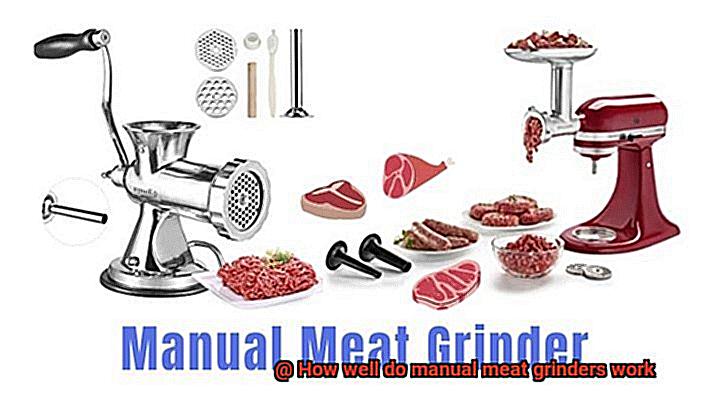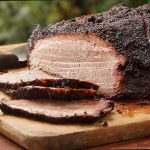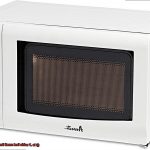Calling all meat aficionados. Have you ever pondered the perfect way to grind your meat? Well, look no further than the trusty manual meat grinder. In a world where kitchen appliances and gadgets reign supreme, this simple yet effective device has stood the test of time. But the big question is – how well do they actually work?
Manual meat grinders are a godsend for those who crave control over the texture and consistency of their ground meat while keeping the flavors intact. They work by using a hand crank to push meat through various blades or plates, resulting in a customized meat grind that caters to your specific needs.
However, many people are skeptical about manual meat grinders’ efficiency. Will they produce enough meat to feed an entire family? Is the process too laborious and time-consuming? Fear not, as we will explore the effectiveness of manual meat grinders in this blog post. We’ll discuss how well they work, their benefits, and any potential drawbacks. Whether you’re a home cook or professional chef, join us as we dive into the world of manual meat grinders and discover the best way to grind your meat to perfection.
Contents
What Are Manual Meat Grinders?
If you’re looking for an easy and effective way to grind your meat manually, a manual meat grinder may be the perfect tool for you. These kitchen devices have been around for centuries, and they still remain a popular option today, thanks to their versatility and convenience.
So what exactly are manual meat grinders? They consist of a hopper, a hand-cranked mechanism, and a set of blades. You simply place the meat in the hopper and turn the crank, which moves the meat towards the blades. The blades then grind the meat as it passes through them, and the ground meat is collected in a container placed under the grinder.
One of the biggest advantages of using a manual meat grinder is that it allows you to have complete control over the texture of your ground meat. By adjusting the blades, you can achieve the perfect coarseness or fineness for your needs. Additionally, manual meat grinders don’t require electricity or any other power source, making them perfect for use in areas where electricity is limited or during outdoor activities like camping or hunting.
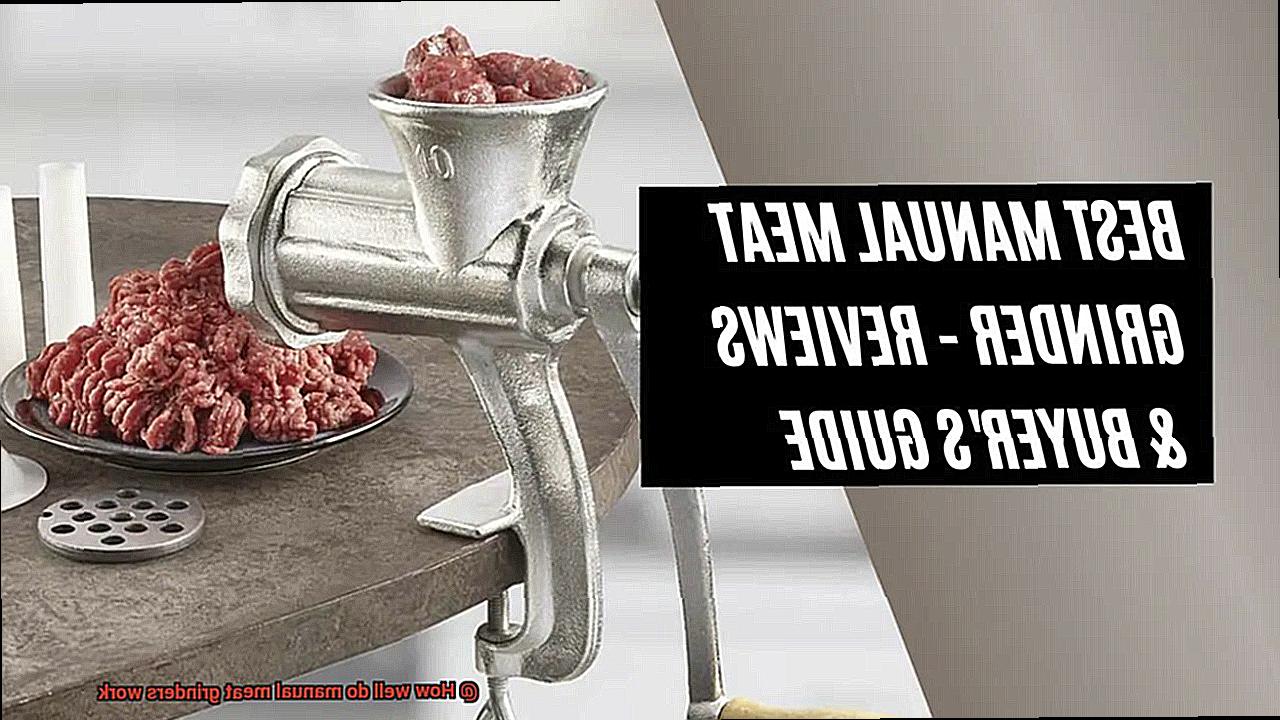
When it comes to choosing a manual meat grinder, there are several factors to consider. These include size, style, and material. Some grinders are made of plastic, while others are made of metal. Some are designed for specific types of meat, such as beef or pork.
To get the most out of your manual meat grinder, there are a few tips to keep in mind. First, make sure to cut your meat into small pieces that fit easily into the hopper. This will make grinding much easier and more efficient. Next, always adjust the blades according to your desired texture. Finally, be sure to clean your grinder thoroughly after use to ensure it continues to produce high-quality ground meat.
Benefits of Manual Meat Grinders
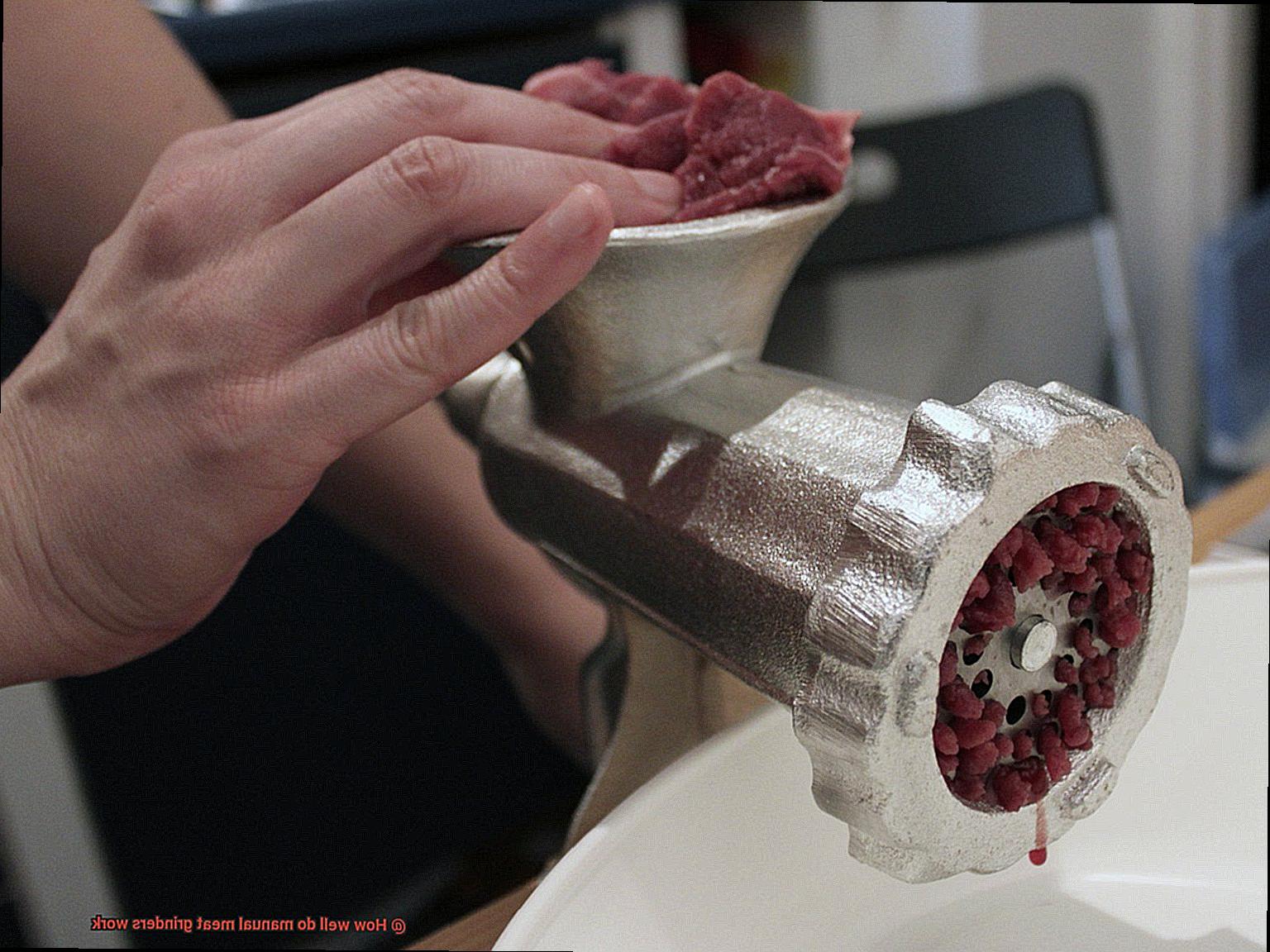
These gadgets have been around for centuries and continue to be a popular choice for several reasons.
One of the most significant benefits of using a manual meat grinder is the complete control it gives you over the grinding process. By adjusting the size of the grinding plate, you can choose the texture of your meat, whether you like it coarse or fine. This customization means that you can tailor your ground meat to fit the specific needs of any recipe.
Another advantage of manual meat grinders is their ability to preserve the nutritional value of your meat. Unlike electric grinders, manual grinders don’t create heat during the grinding process, which can strip away essential vitamins and minerals. This means that you can enjoy healthier meals knowing that your meat retains its nutritional value.
Manual meat grinders are also considerably cheaper than electric grinders, making them an affordable option for those on a budget. Plus, they don’t require any electricity to operate, making them ideal for outdoor cooking or camping trips.
Cleaning and maintaining manual meat grinders is also easy since they usually come with fewer parts than electric grinders. You can disassemble and clean them after use quickly, ensuring that they remain hygienic and safe to use.
Perhaps one of the most appealing features of manual meat grinders is their versatility. You can grind different types of meats, including beef, chicken, pork, and even fish, allowing you to create a range of dishes. They’re also perfect for making sausages and burgers, giving you even more culinary options.
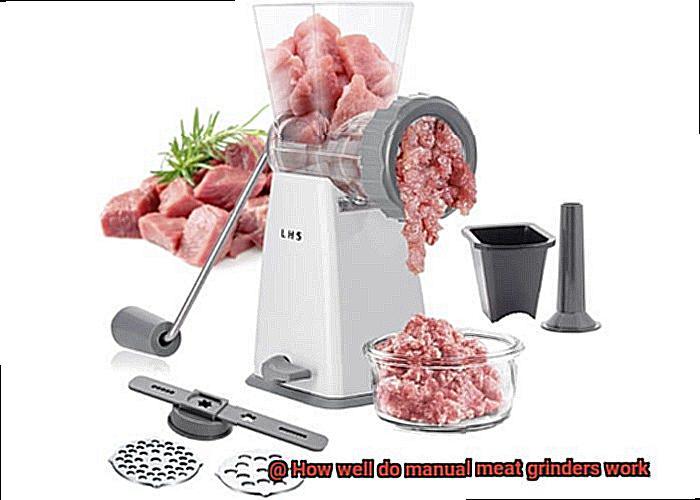
How Powerful Are Manual Meat Grinders?
If you’re a home cook looking to grind your own meat, you may be wondering how powerful manual meat grinders are compared to electric models. As an expert in this field, I can tell you that while manual meat grinders may not be as powerful as their electric counterparts, they offer a host of benefits that make them a must-have kitchen tool.
Manual meat grinders are designed to rely only on the power of your hands. The power of a manual meat grinder depends on several factors, including the size and quality of its components and the strength of the person using it. Some manual meat grinders are designed with larger blades and plates to increase their grinding power, but even the most powerful manual meat grinder will require some effort to use.
Grinding meat manually can be a physically demanding task, especially if you are grinding large quantities or tougher cuts of meat. However, many people prefer manual meat grinders over electric models because they offer greater control over the grinding process. With a manual meat grinder, you can adjust the thickness of your grind and ensure that your meat is ground to your desired consistency.
Manual meat grinders are typically made of durable materials such as stainless steel or cast iron, making them long-lasting and easy to clean. They also come in a variety of sizes and styles to suit different grinding needs. Here are some sub-topics that may interest you:
- Size and style: Manual meat grinders come in different sizes and styles to suit different grinding needs. If you’re planning on grinding small amounts of meat at a time, a smaller grinder may be sufficient. On the other hand, if you plan on grinding larger quantities, a bigger grinder with a larger hopper will be more suitable.
- Components: The size and quality of the components in your manual meat grinder will determine its overall power and performance. Look for grinders with larger blades and plates for increased grinding power.
- Comfort: Grinding meat manually can be a physically demanding task. Choose a manual meat grinder that is comfortable to use and has a sturdy base for stability.
Ideal Uses for Manual Meat Grinders
Discover the wonders of manual meat grinders, a timeless kitchen tool that has been used for generations by families and chefs alike. These simple yet effective devices can grind a variety of meats, from beef to chicken, pork to venison, and more. They allow you to have complete control over the texture and consistency of your meat, making them ideal for certain dishes.
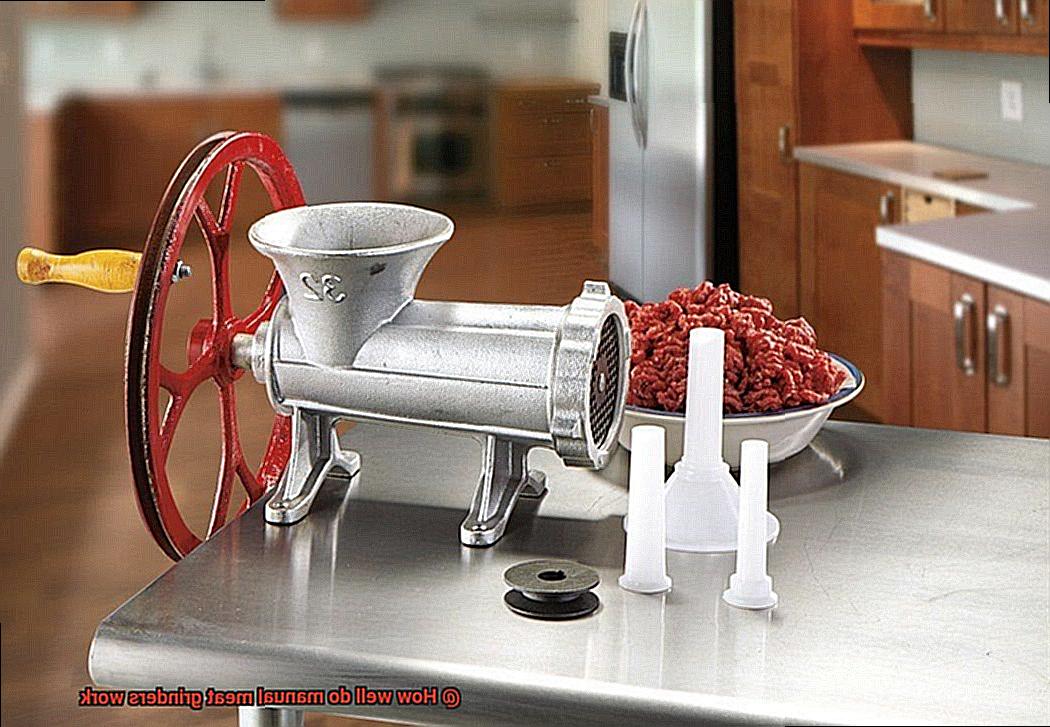
One of the most popular uses for manual meat grinders is making homemade sausage. Sausages require a specific texture and consistency that can be difficult to achieve with pre-ground meats from the grocery store. With a manual meat grinder, you can grind your own meat and add your desired seasonings and spices to create a custom blend that is perfect for your recipe. You can even experiment with different combinations of meats to create unique sausage flavors.
Another ideal use for manual meat grinders is making ground beef or turkey for burgers or meatballs. By grinding your own meat, you can ensure that it is fresh and free from any additives or preservatives. Plus, you can control the fat content, which is crucial for achieving juicy and flavorful burgers. Add in your favorite seasonings and spices to take your burgers or meatballs to the next level.
Manual meat grinders are also perfect for making pet food. Many pet owners prefer to make their own pet food because they want to ensure the quality of commercial pet food. With a manual meat grinder, you can easily grind up fresh meats and vegetables to create a healthy and nutritious meal for your furry friends. You can even adjust the texture of the food to suit your pet’s preferences.
Lastly, manual meat grinders are an excellent tool for making baby food. Parents who want to prepare their baby’s food from fresh ingredients will appreciate this versatile kitchen tool. A manual meat grinder makes it easy to grind up cooked meats and vegetables into purees that are perfect for babies who are just starting to eat solid foods. You can customize the purees to your baby’s taste preferences and dietary needs.
Types of Meats Suitable for Manual Meat Grinders
If so, using a manual meat grinder is a great way to get started. However, it’s important to know which types of meat are best suited for manual grinding. Here are five sub-sections that detail the types of meats suitable for manual meat grinders:
Beef
When it comes to manual grinding, beef is a top choice. Cuts like chuck, sirloin, and round have a good balance of fat and lean meat, resulting in juicy and flavorful ground beef that’s perfect for burgers, meatballs, and more. Plus, the fat content in beef makes it easy to grind.
Pork
Another great option for manual grinding is pork. Pork shoulder or butt have a high fat content that keeps the meat moist and tender during the grinding process. Ground pork is perfect for making sausages, meatloaf, and other dishes that require a juicy and flavorful meat.
Chicken and turkey
While chicken and turkey are leaner meats compared to beef and pork, they can still be ground with a manual grinder. It’s important to use boneless cuts like chicken breast or turkey breast for easier grinding. These meats are perfect for creating healthier versions of your favorite dishes.
Lamb
Lamb has a unique flavor that works well in dishes like meatballs or kebabs. However, it’s important to choose lean cuts like leg or loin to ensure good results. Adding some extra fat while grinding can help keep the meat moist.
Veal
Finally, veal is another option for manual grinding. Like lamb, it’s leaner than beef or pork but can be made more tender by adding some extra fat during the grinding process.
Factors to Consider When Buying a Manual Meat Grinder
A manual meat grinder is an excellent option for home chefs looking for more control over their ingredients. However, before you make a purchase, there are several critical factors to consider.
Firstly, the size of the grinder is essential. If you only plan to grind small quantities of meat occasionally, then a smaller grinder may be suitable for your needs. However, if you have a larger family or frequently cook meals that require ground meat, then a larger grinder would be more appropriate. Don’t waste time and money on a grinder that doesn’t meet your requirements.
Durability is another crucial factor to consider when buying a manual meat grinder. You want a model that can withstand repeated use without breaking down. Look for grinders made from high-quality materials such as stainless steel or cast iron that are built to last. You don’t want to invest in a flimsy model that will wear out quickly and leave you back at square one.
Ease of use and maintenance should also be taken into account. The grinder should be easy to assemble and disassemble, with all parts easily accessible for cleaning. Some models may have specific cleaning instructions or recommendations, so be sure to check these out before purchasing. You don’t want a complicated machine that will leave you frustrated and unable to clean it properly.
Lastly, the grinding capacity of the meat grinder should not be overlooked. Depending on your needs and preferences, you may want a grinder with attachments for varying levels of coarseness or one with different speeds for grinding. Don’t settle for a model that doesn’t give you the results you desire.
Maintenance and Care Tips for Manual Meat Grinders
To ensure that these machines work efficiently and last for years, it’s crucial to take good care of them. Here are five essential maintenance and care tips for your manual meat grinder:
Clean the Grinder Regularly
Meat residue can easily build up in your manual meat grinder, affecting its performance. Therefore, it’s essential to clean it thoroughly after every use. Disassemble the grinder and wash each part with hot, soapy water. Avoid using harsh detergents or abrasive sponges as they can damage the parts. Once you’ve washed them, dry them thoroughly before reassembling the grinder.
Lubricate the Grinder
To keep your manual meat grinder running smoothly, lubricate its gears and moving parts regularly with food-grade oil or petroleum jelly. This will prevent rust and ensure smooth operation.
Store the Grinder Properly
When not in use, store your manual meat grinder in a dry and cool place away from direct sunlight or moisture. This will prevent rusting or damage to its components and extend its lifespan.
Sharpen the Blades
Dull blades can make your manual meat grinder work harder than necessary, leading to overheating or motor damage. To ensure efficient grinding, sharpen the blades periodically using a sharpening stone or honing steel.
Avoid Grinding Bones
While manual meat grinders can handle many types of meats, they are not designed to grind bones. Grinding bones can damage the blades and gears, leading to costly repairs or replacement.
ql_z53zgUSE” >
Conclusion
In conclusion, manual meat grinders are a kitchen essential that offer unparalleled control over the texture and consistency of your ground meat. Despite their simplicity, they have stood the test of time and remain a popular choice for home cooks and professional chefs alike. By using a hand-cranked mechanism to push meat through various blades or plates, you can achieve customized meat grinds that cater to your specific needs.
Manual meat grinders outshine electric grinders in several ways. They preserve the nutritional value of your meat, are more affordable, and do not require electricity to operate. Additionally, they are easy to clean and maintain due to their fewer parts compared to electric grinders. Although manual meat grinders may not be as powerful as their electric counterparts, they offer greater control over the grinding process.
When purchasing a manual meat grinder, it’s crucial to consider factors such as size, durability, ease of use and maintenance, and grinding capacity. To ensure optimal efficiency and longevity from these devices, proper care is essential. Regular cleaning, periodic lubrication of gears and moving parts, proper storage when not in use, blade sharpening at intervals, and avoiding grinding bones will keep them working efficiently for years.

